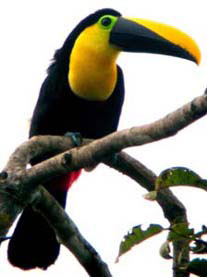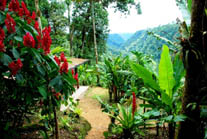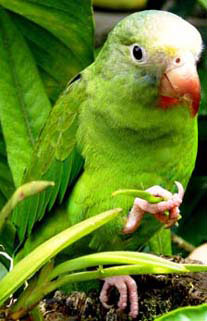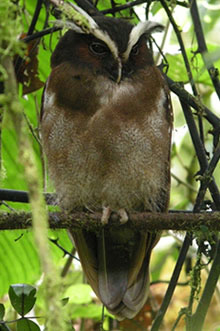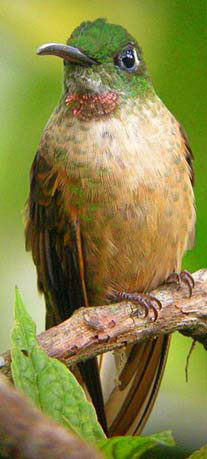The Magic Birding Circuit of EcuadoR
Bird List 2010
If you would like a copy of the 2010 Magic Birding Circuit Birding List, please contact birdwatching@eco-lodgesanjorge.com
Ecuador Magic– Wingspan Australian Birding Magazine –
A new eco-tourism initiative in one of the most biodiverse places on Earth.
By Bruce Thomson
As I drove up the massive, dissected form of the great Andean mountain range in Ecuador, its summits pushing through the snow line up to more than 6,000 metres, and its lower foothills lapping the Pacific Ocean, I pondered why this tiny country, which is just 3.6 per cent the size of Australia, is so remarkably diverse. With over 1,600 species of birds—almost double our national species tally—this South American nation boasts an amazing 20 per cent of the world’s total species.
The figures are even more astounding when you consider that many of these species are endemic to Ecuador and the Andes region and can be found nowhere else, making the Choco/Darien region of western Ecuador one of the world’s 25 ‘conservation hotspots’. These hotspots (which include our own Great Western Woodlands in WA), cover only 1.4 per cent of the earth’s total surface area, but contain 44 per cent of all vascular plants and 35 per cent of all vertebrates.
Approaching the peaks, I tried to imagine the climatic and tectonic forces that must have played dramatically upon the Ecuadorean landscape for millions of years. Even today, the Andes continue to rise as the leading edge of the Nazca plate is driven below the boundary of the South American plate, thrusting the mountains higher by an estimated 2-3 centimetres each year.
Mountain building in this region of the world started long ago and it is thought that the Andes had already attained sufficient height to support the range of climatic conditions and habitats that we find today some 15 million years ago. At the higher altitudes above the treeline, the high, barren plains or ‘páramo’ dominate. Spanish for ‘desolate territory’, the páramo is a windswept, alpine environment, its expanses covered in low cushion-like herbs and wispy grasses, intersected with swamps and bogs. Progressively further down the mountains we find temperate montane shrublands and forests, and then lower still we encounter sub-tropical cloud forest. At less than 1,000 metres, in the foothills, tropical equatorial forests dominate.
The high levels of endemism found in the region have led biologists to suggest that pockets of these forest environments remained untouched by the Pleistocene glaciations that occurred some 2 million to 10,000 years ago. In these protected and isolated refuges, species were able to survive in relatively stable conditions. Genetically isolated, they diverged and adapted to give rise to the diversity we see today.
As a recognised biodiversity hotspot, Ecuador has attracted a good deal of attention from conservation groups the world over. Indeed, groups including BirdLife International have made significant contributions by providing funds for conservation projects to protect key areas. But a good deal more is still required, if you talk to Dr George Cruz, a native Ecuadorian with a lifelong passion for conservation, and particularly for birds. Dr Cruz started his career as a vet, but his interest in nature finally got the better of him and, after restoring the property that he inherited—an 18th century hacienda in the foothills of Quito—he embarked upon a program to acquire land in each of Ecuador's different biological environments.
His strategy for conservation is simple and logical. At the present time, approximately 20 per cent of the country is protected as national park, but Dr Cruz can see that much more is required, if conservation measures are to be truly effective. Just as we have recognised the importance of community conservation initiatives in Australia, Dr Cruz believes that community involvement is the key to successful conservation in Ecuador.
On the winding road that climbs towards the páramo near Mount Antisana, Dr Cruz explains his intentions with conviction and a good hint of optimism, “if we want conservation to be effective, then we have to make sure that local people are involved and can see the value in what they are doing. To do that, we have to give wildlife a value. The people here need to see that they can benefit through their conservation actions.” For instance, in the area we are heading to, he says that “It’s the farmers who set poison baits for the condors, fearful of losing their stock. But if we can show the farmers that they can benefit economically from the birds, earning money from eco-tourism as people come here to see them, then we can achieve conservation.”
So, armed with determination and an abiding love for Ecuador and its wildlife, Dr Cruz has backed his land acquisition program with a strategy based on bringing economic benefits to local communities through eco-tourism. “We call it the Magic Birding Circuit,” says Dr Cruz. His plan is to acquire land and to build a series of bird lodges, each within two hours drive of one another, and each in a different natural environment with different bird species. It’s rather extraordinary to think that one can find entirely different species cohorts so close to each other, but such is the diversity and range of habitats available in Ecuador.
So far, Dr Cruz has four parcels of land, including his original property in the foothills overlooking Quito, which is at an altitude of approximately 2,700-4,000 metres. This land encompasses the lower and mid elevations of the páramo and consists of dense shrublands with scattered small trees. The area also supports a very healthy stand of Eucalyptus globulus (Tasmanian Blue Gum) and other Australian plants. The eucalypts are used extensively for wood in the local area and are now a locally important economic species. Despite these introductions, the property still retains most of its native vegetation and all the birds that are typically associated with it, including the superlative Sword-billed Hummingbird with its remarkably long bill specifically adapted to extracting nectar from long-tubed flowers like the Datura.
Dr Cruz has also established a sanctuary in the well-known birding hotspot at Tandyapa in the cloud forests of the Choco region of western Ecuador at about 1,700 metres. Cloud forests are, as their name suggests, shrouded for much of the time in dense fog and derive a good deal of their moisture from leaf-drip. The trees are relatively short and multi-stemmed, and cloaked in lichens, fungi and an amazing assortment of bromeliads. Species diversity in these forests is not necessarily as high as in lowland rainforests, but a very high percentage of species that do occur are endemics. At Tandayapa, there are at least 26 species of hummingbirds that frequent the feeders, as well as an assortment of tanagers and other magnificent species such as the Golden-headed and Crested Quetzals.
At Cosanga-Yanayacu Reserve, a lodge is currently under construction also located in cloud forest but at a slightly higher altitude on the border of Antisana National Park on the eastern slope of the Andes. Many mammal specialties such as ocelots and Spectacled Bears inhabit this area, as do such memorable birds as Andean Cock-of-the-rock and Crested Quetzal.
The Milpe Reserve is located in tropical rainforest at an altitude of approximately 1,000 metres. In this very dense vegetation, only a small percentage of the sunlight filters through to the forest floor and so many plants in the ground layer have developed large leaves to maximise light collection. This is the home of plants such as the monsteria, which is well-known around the world. Species diversity is greatest in these warm, wet forests and at the Milpe Reserve many of the iconic South American species, including Toucans and Aracaris, can be seen. The area also boasts some very rare species, such as the Banded Ground-Cuckoo which is listed by BirdLife International as one of the 50 rarest birds in the world.
Dr Cruz is also investing in the human resources needed to run and maintain his eco-tourism and conservation operation. On our visit we met some young trainees working in the Quito office and an Ecuadorian student studying eco-tourism at the local university and working to develop her English skills with the help and encouragement of Dr Cruz.
Where will it all end? Dr Cruz smiles, “I put funds that I earn from the lodges back in to buying more land, so it will all depend on how many tourists come and what I can afford.”
Cheryl Korowotny
International Director
The Magic Birding & Photography Circuit
SAN JORGE ECO-LODGES & BOTANICAL RESERVES
Quito – Tandayapa – Milpe - Cosanga - Estero Hondo-Sumaco Bajo-Guacamayos
Ecuador – South America
Email: birdwatching@eco-lodgesanjorge.com
(877) 565-2596 Toll Free USA & Canada.
Magic Birding & Photography Circuit Map
San Jorge has been awarded the Trip Advisor Certificate of Excellence for the past 11 consecutive years!



